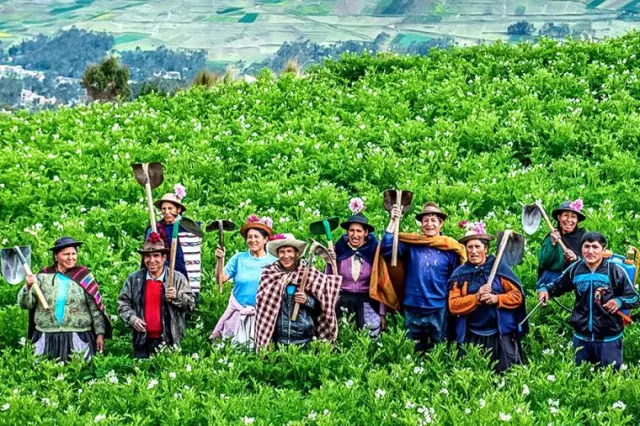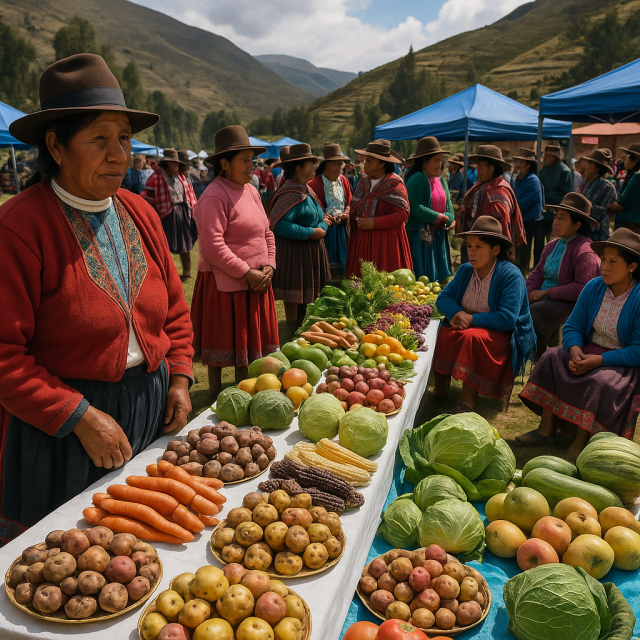Why is Peasant Day celebrated in Peru? This commemoration is one of the most significant on the national civic calendar, as it honors those who have historically sustained the country's productive and food supply. Every June 24, Peru celebrates the peasants, the women and men who, with effort and dedication, work the land from very early in the morning, often in adverse weather conditions and with limited resources.
Far from being a merely symbolic date, Farmers' Day reflects a continuing reality: the Peruvian countryside continues to be the driving force of national agriculture and a key pillar for economic and cultural development. Furthermore, this date invites us to examine the reality of agriculture with greater sensitivity, recognize its structural challenges, and promote concrete actions to strengthen it.
The historical origin of Farmers' Day
From “Indian Day” to “Farmer’s Day”
The history of Peasant Day has deep roots in 20th-century politics and culture. In 1930, then-President Augusto B. Leguía established "Indian Day" to raise awareness of the country's Indigenous communities, often marginalized and forgotten by the state system. This date was chosen with special symbolism, as June 24 marks the celebration of Inti Raymi , or Festival of the Sun, an ancient Inca ceremony that marks the winter solstice in the Andes.
Over time and with political changes, this date took on a new meaning. During the government of General Juan Velasco Alvarado , as part of the 1969 Agrarian Reform , the name was changed to "Farmer's Day." This change reflected a more inclusive vision of rural workers, regardless of their ethnicity, and sought to dignify the work of all Peruvian peasants, who until then had largely been excluded from the benefits of progress.

The importance of the peasantry today
Pillar of food security
The Peruvian peasantry is not only a cultural symbol but also a key economic player . More than 70% of the food we consume in cities comes from the efforts of small rural producers. They cultivate crops from the Andean highlands to the Amazon, offering an impressive variety of products that make Peru one of the countries with the greatest food biodiversity in the world.
Thanks to the daily work of farmers, the country is internationally recognized for its production of potatoes, corn, quinoa, coffee, cocoa , and other crops that are part of our basic diet and are also important export products.
Preservers of ancestral knowledge
Peasant knowledge goes far beyond sowing and harvesting. It is knowledge accumulated over generations , combining sustainable agricultural practices, respect for nature, and a spiritual relationship with the land. Many of these practices have pre-Incan origins and continue to be practiced through oral and community transmission.
A notable example is the use of agricultural terraces , which optimize water use and prevent soil erosion in steep areas. These systems, far from being obsolete, are models of sustainability that even inspire modern agriculture in times of climate change.
Rural development agents
Farmers are not only food producers, but also managers of rural development . In many communities, they play multiple roles: they are community leaders, transmitters of culture, promoters of experiential tourism, and guardians of ecological heritage. Their influence on the local economy is vital, as they stimulate markets, generate employment, and keep productive chains active.
However, this prominence contrasts with the difficulties they still face. Many farmers lack access to technical education , adequate road infrastructure , health services , and modern agricultural technology . These structural challenges limit their opportunities and affect the competitiveness of the agricultural sector.
How Peasant's Day is celebrated in Peru
Festivities and activities in different regions
Peasant Day is celebrated with enthusiasm and respect in various regions of the country, especially in the high Andean and rural areas. Festivities vary by location, but generally include:
Agricultural fairs where native products, farm animals, agricultural tools, and seeds are displayed.
Cultural ceremonies with folk dances, traditional music, and Andean rituals in honor of Pachamama.
Official recognition by municipalities or the State to outstanding farmers for their innovation or performance.
Processions and masses in areas where popular religiosity is integrated with peasant identity.
These celebrations highlight agricultural work , encourage local consumption, promote partnerships among producers, and strengthen the bond between urban residents and farmers.
State support and pending challenges
Rural sector support programs
The Peruvian State, through the Ministry of Agrarian Development and Irrigation (MIDAGRI) , implements various programs focused on improving the situation of farmers. Some of the most important are:
Agroideas: support for agricultural innovation through business plans.
Agroperú Fund: accessible loans for small producers.
Sierra y Selva Exportadora: promoting the marketing of regional products with added value.
Senasa: technical assistance to ensure agricultural safety and health.
However, the coverage of these programs is still limited. It is necessary to expand public investment in rural areas, prioritizing irrigation, connectivity, electrification, and market access projects.
Structural challenges to overcome
The main problems affecting the peasantry in Peru are:
Land concentration: Although the Agrarian Reform distributed land, today there is a new land grab by large agro-exporting companies.
Climate change: The increase in droughts, frosts, and irregular rainfall affects crops and puts food security at risk.
Rural-urban migration: Young people are leaving the countryside due to a lack of opportunities, which is aging the rural population.
Weak institutionality: lack of effective political representation for the peasantry.
To reverse this situation, a multisectoral rural agenda is needed that considers farmers not as a vulnerable population, but as a strategic player in development.

A legacy that nourishes Peru
Today, more than ever, we must recognize that Peru's future also depends on the countryside. The peasantry not only guarantees the food we consume daily, but also upholds fundamental values such as solidarity, collective wisdom, respect for the land, and self-sufficiency.
Farmers' Day is an occasion to pay tribute, but also to demand concrete actions that improve their quality of life. Investing in agriculture is not only a moral duty, but a smart investment for the country's sustainability. May this day inspire us to look differently at the land, its fruits, and, above all, at those who, with their daily efforts, make it flourish.
Frequently asked questions about Farmers' Day
Why is Farmers' Day celebrated on June 24?
Because it coincides with Inti Raymi, an Inca festival honoring the Sun, a symbol of agricultural fertility. June 24th has been adopted as the official date to honor the work of farmers since 1969.
What is the difference between Indian Day and Peasant Day?
"Indian Day" had an ethnocultural focus on indigenous populations. "Peasant Day," on the other hand, encompasses all rural workers, regardless of ethnicity, recognizing their productive and social role.
What products do Peruvian farmers grow?
Among the main products are potatoes, corn, quinoa, coffee, cocoa, broad beans, olluco, Andean fruits, among others. Many are native to Peru and are in high international demand.
What challenges do farmers face today?
They face a lack of access to credit, poor infrastructure, climate vulnerability, and limited political representation. Furthermore, many work informally and without social protection.
How can I support the Peruvian peasantry?
By purchasing local products, participating in farmers' markets, promoting rural tourism, demanding fairer public policies, and promoting their work through media and social media.
